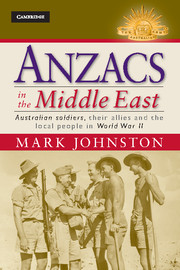Book contents
- Frontmatter
- Contents
- Photographs
- Maps
- Preface
- Acknowledgements
- Abbreviations
- Introduction
- Chapter 1 Travelling to the ‘great adventure’
- Chapter 2 ‘A different world’
- Chapter 3 ‘They're troublesome, you know’
- Chapter 4 ‘Fighting shoulder to shoulder’
- Chapter 5 ‘Australia, Australia, you are good’
- Chapter 6 ‘Unity of feeling and purpose’
- Chapter 7 ‘They treat us as a dependent nation’
- Chapter 8 ‘Gyppo Land’
- Conclusion
- Notes
- Bibliography
- Index
Chapter 1 - Travelling to the ‘great adventure’
Published online by Cambridge University Press: 05 February 2013
- Frontmatter
- Contents
- Photographs
- Maps
- Preface
- Acknowledgements
- Abbreviations
- Introduction
- Chapter 1 Travelling to the ‘great adventure’
- Chapter 2 ‘A different world’
- Chapter 3 ‘They're troublesome, you know’
- Chapter 4 ‘Fighting shoulder to shoulder’
- Chapter 5 ‘Australia, Australia, you are good’
- Chapter 6 ‘Unity of feeling and purpose’
- Chapter 7 ‘They treat us as a dependent nation’
- Chapter 8 ‘Gyppo Land’
- Conclusion
- Notes
- Bibliography
- Index
Summary
There's no doubt we have some blasted good fun when we go out on a sightseeing tour and some of the things these wild sojers [sic] do would make you split your ribs laughing and wonder how they think of such mad doings. I wish I could tell some of them now.
Pte A.J. Ulrick, 2/2nd Battalion, letter, 7 February 1940The typical Australian soldier who embarked for overseas service had a humble educational and occupational background. A census taken in 1942–43 indicated that about two-thirds of all Australian soldiers had left school at or before age 14. Only 7 per cent had completed a full secondary course and 1.4 per cent a degree or diploma. Labourers and clerical workers predominated in the AIF in its early years. Before enlisting, nearly nine out of ten had been employees or without paid work. There was probably a higher proportion of manual labourers than usual in the other ranks of combat units, although their officers generally came from non-manual, ‘inspectional’, ‘managerial’ and ‘high administrative’ occupations.
Consequently, the men who sailed off to meet their adventure and do their duty from 1940 onwards generally knew little about the places and people they were about to visit. Few had enjoyed an opportunity to learn much about these locations. Even fewer could have afforded to travel overseas before the war, although an undefinable but small number had been overseas in the First AIF. For most, the journey overseas was a personal, existential voyage into uncharted waters. In this sense they were ‘innocents abroad’ and, like children on tour, they often gave headaches to those in charge of them and to the inhabitants of their ancient destinations. One must not push this analogy too far, as much of the misbehaviour was very adult in orientation.
- Type
- Chapter
- Information
- Anzacs in the Middle EastAustralian Soldiers, their Allies and the Local People in World War II, pp. 4 - 21Publisher: Cambridge University PressPrint publication year: 2012



